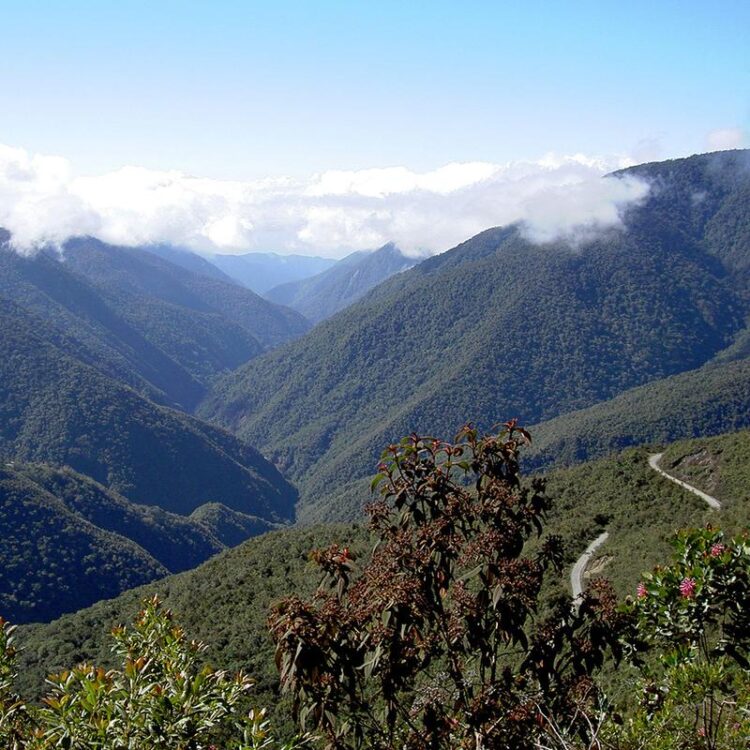Informing future conservation priorities of ecosystems in the Tropical Andes

Central Andean (Yungas) Montane & Upper Montane Humid Forest.
Pat Comer, NatureServe
New research offers a pathway to achieving the 30 by 30 target using ecosystem diversity across four South American countries protected areas.
There is an opportunity to increase the representation of ecosystems to 31% across four Andean countries through the additional protection of Key Biodiversity Areas (KBAs). This is shown in a new study led by NatureServe, iDiv and Martin Luther University Halle-Wittenberg (MLU), together with other institutions. The study, published in the journal Remote Sensing demonstrates how Essential Biodiversity Variables (EBVs) coupled with KBAs can inform conservation decisions at multiple scales.
Joint press release by iDiv and NatureServe
To effectively conserve ecosystems, scientists document and monitor their extent (mapped areas where they occur) and conservation status over time. Combining trends in extent with degree of protection helps to accurately assess the effectiveness of conservation actions. This is what an international research team led by NatureServe and iDiv has illustrated for conservation planning in the most biologically diverse area on the planet, the Tropical Andes. Using pre-industrial and recent maps for ecosystems in the Tropical Andes, the team measured long-term ecosystem loss to intensive land uses. They then quantified representation of ecosystem types in the region within current protected areas, and additional representation offered by protecting Key Biodiversity Areas.
Findings revealed only five of 95 ecosystem types within the Tropical Andes hotspot have at least 30% of their area protected – the target for percent of land and waters that all countries should conserve by year 2030, as advised by the Convention on Biological Diversity. However, the number of ecosystem types adequately protected could increase to 39 when considering ecosystems across Bolivia, Ecuador, Colombia, and Peru if governments and civil society act to protect Key Biodiversity Areas – places that meet the internationally recognized standard for sites that contribute significantly to the global persistence of biodiversity.
The researchers arrived at this conclusion by applying the concept of Essential Biodiversity Variables (EBVs), which assist in measuring different aspects of biodiversity relevant to conservation assessment, planning and policy. Analyses based on EBVs help to create a baseline for assessing change in terrestrial ecosystems to measure the impact of national policies and gauge progress of commitments towards conservation goals.
“From this study, we can see where some ecosystems have been disproportionately lost to intensive land uses,” says Pat Comer, lead author of the study and Chief Ecologist at NatureServe. “We can also see where some of our investments in land conservation have done well at securing some ecosystems while doing less well with others. By recognizing and conserving the full diversity of ecosystems, we conserve the natural setting for all species to survive and evolve.”
Development of the EBVs involved hundreds of people over many years, including local collaborators from the Tropical Andes, and included many scientists and community members who participated in regional and national workshops in Colombia, Ecuador, Peru, and Bolivia.
“This EBV indicator links conservation goals at the global, national and local levels. More importantly, the EBV responds directly to the needs expressed by people in these countries,” says second author Dr Jose W. Valdez, postdoctoral researcher at MLU and researcher at iDiv. “Using an EBV framework can help bridge the gap between scientists and local communities and be a valuable tool to protect ecosystems and species diversity around the world.”
“While this study focused on the Tropical Andes, the data used to map and analyze ecosystem indicators can inform continental or even global conservation decisions”, emphasizes Dr Sean T. O’Brien, President and CEO of NatureServe. “This study shows that while we have not yet adequately protected all natural ecosystems, we are able to improve the representation of ecosystem diversity if we protect our natural areas.”
Wissenschaftliche Ansprechpartner:
Dr Jose W. Valdez
(speaks Spanish and English)
Postdoctoral Researcher
Research group Biodiversity Conservation
German Centre for Integrative Biodiversity Research (iDiv) Halle-Jena-Leipzig
Martin Luther University Halle-Wittenberg
Phone: +49 341 9739168
Email: jose.valdez@idiv.de
Web: https://www.idiv.de/en/profile/1290.html
Originalpublikation:
Comer, P. J., Valdez, J. W., Pereira, H. M., Acosta-Muñoz, C., Campos, F., Bonet García, F. J., Claros, X., Castro, L., Dallmeier, F., Domic Rivadeneira, E. Y, Gill, M., Josse, C., Lafuente Cartagena, I., Langstroth, R., Larrea-Alcázar D, Masur, A., Morejon Jaramillo G., Navarro, L., Novoa, S., Prieto-Albuja, F., Rey Ortíz. G., Teran M. F., Zambrana-Torrelio C., Fernandez Trigoso, M. A. (2022): Conserving Ecosystem Diversity in the Tropical Andes. Remote Sensing. DOI: 10.3390/rs14122847
Weitere Informationen:
Media Contact
All latest news from the category: Ecology, The Environment and Conservation
This complex theme deals primarily with interactions between organisms and the environmental factors that impact them, but to a greater extent between individual inanimate environmental factors.
innovations-report offers informative reports and articles on topics such as climate protection, landscape conservation, ecological systems, wildlife and nature parks and ecosystem efficiency and balance.
Newest articles

Breaking boundaries: Researchers isolate quantum coherence in classical light systems
LSU quantum researchers uncover hidden quantum behaviors within classical light, which could make quantum technologies robust. Understanding the boundary between classical and quantum physics has long been a central question…

MRI-first strategy for prostate cancer detection proves to be safe
Active monitoring is a sufficiently safe option when prostate MRI findings are negative. There are several strategies for the early detection of prostate cancer. The first step is often a…

Microelectronics Science Research Centers to lead charge on next-generation designs and prototypes
Pacific Northwest National Laboratory to contribute leadership to national effort in microelectronics design and development. Microelectronics run the modern world. Staying ahead of the development curve requires an investment that…



